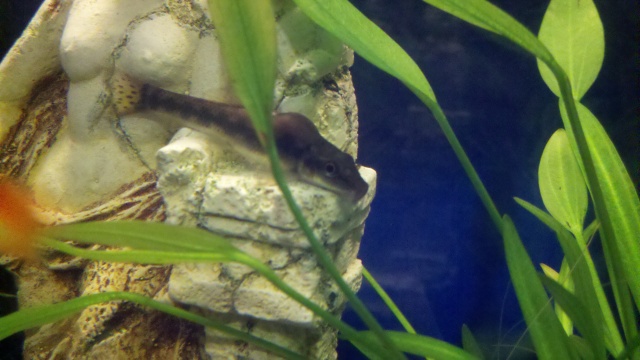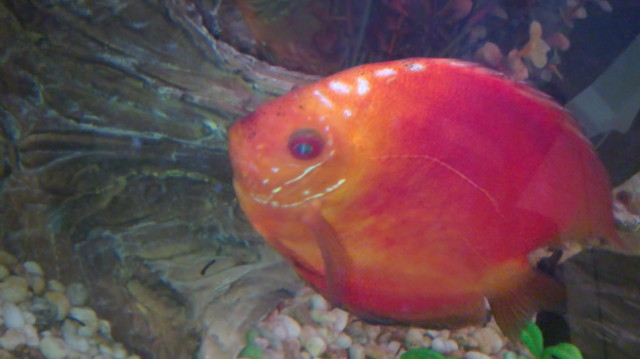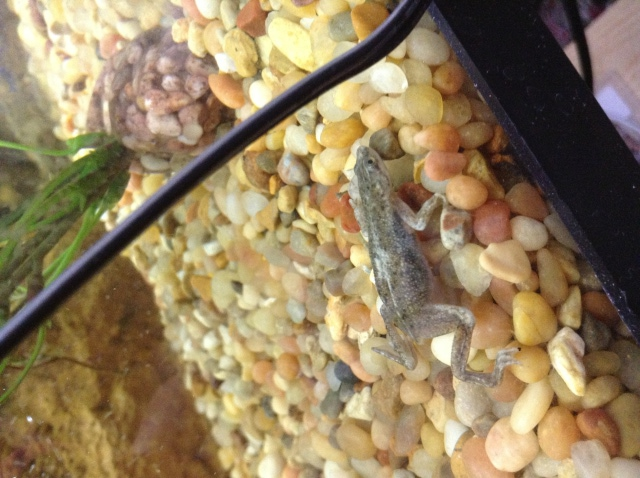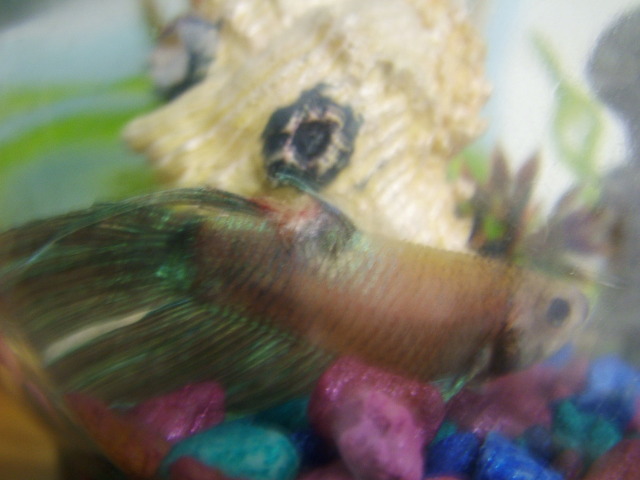QuestionQUESTION: Hi,
A just purchased two female betta a few days ago. They're in a 10 gallon tank right now with a small heater. Both seemed very active when I bought them and my darker, red girl is very energetic. However, my little white and red one doesn't seem to be doing so well.
When I released them into my tank, I noticed that the white betta seemed to have one little, black spot on the top of her back about 1-3 millimeters or so behind her fin. She was swimming around fine and seemed to be alert (I accidentally scared her) so I thought she would be ok. The yesterday she began to hang around the bottom of the tank, only going up for air, while my other betta swam all over the place. When I fed them, she didn't pay attention and ate off of the gravel when the food settled.
I haven't had her long enough to know if this is her normal personality, and I highly doubt it is. Is this a fungus, or could it be because of the poor water condition of the cup she was in? Please answer soon. I've grown very attached to her for such a short period of time.
Thanks,
Emilie
ANSWER: Hi Emilie,
I don't think it is fungus. Watch her carefully over the next few days, and maybe that black spot will disappear seeing as she is now in clean water. I am not for medicating right away until I know for sure what she has. Dilute 2 teaspoons of aquarium salt with your water and put it in your tank. Buy a little bottle of Aquarisol and add 10 drops to your tank. This should help also. Salt and Aquarisol help stressful fish, and prevent disease. I tend to think that she is being dominated by the other female betta. Put lots of hiding places in your tank so she will feel secure. Make sure that it is two females, as younger bettas do look like females. It is hard to tell the difference.
The fact that she is eating is a good sign. What makes me think it's domination stressing her is that she is eating at the bottom of the tank, afraid to come up to eat. Bettas don't usually eat at the bottom. I'm quite sure she is afraid of the other one, and if you put in more hiding places, maybe she will be okay. I hope so.
Hope this helps
Lynda
---------- FOLLOW-UP ----------
QUESTION: Hi again,
Thank you for the advice. I've bought more plants to help with hiding spots and will get a tank divider if it doesn't work out. However, the fact that young young male bettas can be misidentified as females makes me wonder... How do you tell the difference between the males and females other than the fins, and how long will it take for the fins to grow larger if my dominant betta is, indeed, a male? The larger female does have fairly impressive fins for a female, though they're still about the size of a female's fins, and I'm worried about leaving them without a tank divider if she really is a he.
Than again,
Emilie :)
AnswerHi Emilie,
It might be a good idea to get a tank divider if they continue to act this way. Young bettas all look the same, it is very hard to tell the difference until their fins grow. This takes some time. I have bred them and kept them for almost 8 months before I could tell the difference. I did notice a little earlier that the males were aggressive to one another. This is how I could tell the difference, and take them out of the breeding tank, and into a 2 gallon tank. If I had put them on the market earlier, there would have been no way of telling who was the male, and who was the female. The Pet Store wouldn't know either, and sell them as females. They are very slow to mature, so it takes time to see the if they are males or females. It appears that one of your fish is very dominant...enough to scare the other one. It could also be a dominant female. A female can be very aggressive towards another female. They are just like the males actually, they can bite, and they can kill.
Examine the anal fin, if it looks larger, and is sort of pointy, then it could be a male. Females have a white spot under their belly between their ventrals, and their anal fin. This is a tiny spot like a grain of salt. It is called an "ovipositor tube." This is where the eggs come out when she is ready to lay eggs. This could indicate that she is a female. There is also the colour. The males have more vibrant colours. It is very hard to tell the difference when they are young. If you have a young betta, consider youself very lucky, he can be your friend for 5-7 years! We usually don't know their age when we buy them, and that's why some die after a short time with us. Either way, male or female, bettas are aggressive fish. If one of them continues to stay at the bottom, you will have to get her/him a divider, and when she will feel more secure, she will be okay.
Hope this helps
Lynda

 Odd lumps
Question
algae eater
I have got 2 fish that just became
Odd lumps
Question
algae eater
I have got 2 fish that just became
 Discus fish
Question
Discus fish
Since 3 months i have been having
Discus fish
Question
Discus fish
Since 3 months i have been having
 Goldfish diseases
Question
Fantail goldfish
Hi Jaymie,
&nb
Goldfish diseases
Question
Fantail goldfish
Hi Jaymie,
&nb
 African dwarf frog
Question
Side/top Front
My African dwarf
African dwarf frog
Question
Side/top Front
My African dwarf
 Betta Fish Illness
QuestionMy Betta
QUESTION: My betta has been sic
Betta Fish Illness
QuestionMy Betta
QUESTION: My betta has been sic